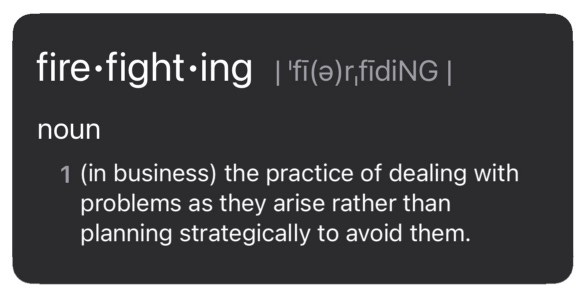Early career leaders often find themselves in a death spiral of never-ending firefighting. They are thrown from one crisis to the next, unable to find any time to pause, take a breath, and come up with a better plan. They have the sense they should be doing proactive work. “But I can’t just ignore the fire,” they think, “how can I possibly find time for proactive work?!”
The truth is that most of the firefighting is self-inflicted.
As a quick aside, it makes sense to distinguish the self-inflicted firefighting from the genuine kind. When the situation is truly dire, and the survival of your organization is on the line, you have no choice but to engage. Working nights and weekends, throwing everything you’ve got into the fight, and even allowing some fires to go on — it’s all fair game. But if that type of all-hands-on-deck disaster strikes your company more than once in a blue moon, you’re more than likely dealing with self-inflicted firefighting.
How do we bring that perpetual state of firefighting onto ourselves? Some common ways are:
- lack of vision,
- lack of process, and
- poor boundaries.
Lack of vision
One of the principal causes of firefighting is the lack of vision — a singular focus that makes it abundantly clear to all interested parties what future your team is working towards. And just as important, what’s not part of that future?
Lacking clear vision, short-term thinking takes root, and it’s tricky to weed out later. The instant gratification of achieving a short-term result is intoxicating. Nothing beats making a red light go green. The short-term results are also easy to point to when it comes time to evaluate your team’s performance. The long-term, less flashy work not only takes longer before you can see the results, but those results are also oftentimes difficult to point to.
Your organization might also inadvertently reward firefighting. A car that runs is not an achievement. On the other hand, if somebody forgets to replace the oil and the car breaks. But then you heroically swoop in and, after a few excruciating hours, save the day by bringing it back to life — that’s something very few companies won’t celebrate… thus creating an incentive for firefighting.
If you like feeling like these folks and don’t mind getting burned from time to time, you can stop reading now.
But if you’re tired of firefighting, here are a couple of thoughts on how to make the sprinkler look like a hero worth celebrating.
When you work on your vision, make sure it spells out in very concrete terms the impact it will produce. If the work you’ll be doing guarantees that the car is operational 364 days out of a year, put that in writing. And remember to note the current numbers so you have something to measure your progress against.
And finally, when all interested parties are on the same page with your vision, it’ll be a lot harder to justify distracting your team with requests that aren’t at least as impactful.
Lack of process
As trivial as this might sound, the lack of an adequate process is not an uncommon problem.
If you find yourself in a situation where the unplanned work keeps coming to you through email, Slack, or even in-person conversations. And you feel compelled to act on it right away, least it falls through the cracks; poor process might be why you’re struggling to get from under the pile. Fortunately, it’s straightforward to fix.
A good process makes it clear when, for what types of requests, and how to engage with your team. Say your team is responsible for providing infrastructure to product teams. When in their lifecycle should they reach out to you? What criteria will you use to evaluate their request? When will you get back to them with the initial response? How long will it take to satisfy their request?
In other words, a good process answers questions and guides folks toward a resolution with as little of your team’s involvement as possible. Even better if you can automate the resolution itself.
Lastly, trust is practically synonymous with predictability. If your process starts to feel like a black hole in which no information ever escapes, people will lose trust, and firefighting will resume.
Poor boundaries
But let’s say your vision has been well received by your organization, and you’ve nailed the process. If the firefighting still continues, you might be dealing with poor boundaries.
Some folks who spent a significant amount of time working in dysfunctional organizations learn to be a squeaky wheel. If you continue to keep your promises, they’ll eventually learn to trust your process. But until that happens, setting clear boundaries is essential.
Saying no to requests at work might feel like you’re being un-collaborative, and nobody wants to be labeled a poor team player. However, saying yes to requests that do not bring you any closer to your vision is harmful to the entire organization.
If you believe it might be worth your effort to learn how to set boundaries in a way that meets everybody’s needs, read next, “How to set clear boundaries at work.”
If, despite having a clear vision, smooth process, and healthy boundaries, you still feel personally overwhelmed with the number of tasks you have to tackle as a manager, read “The biggest reason technical managers fail.”





